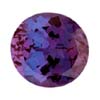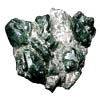- sale
- new items
- lovely beads
- wedding beads
- beads for teens
- for custom order
- newsletter
- recognition
- testimonials
- birthstones
- zodiac signs
- jewelry guide
SHOP BAG
![]() in your bag 0 items
in your bag 0 items
Two unusual varieties of the mineral chrysoberyl have their own names as gemstones: cat's eye or cymophane, and alexandrite. Alexandrite is thought to be the August gemstone as well as green gems jade and peridot. Alexandrite exhibits emerald green, red and orange-yellow colors depending on viewing direction in partially polarized light. However, its most distinctive property is that it also changes color in artificial (tungsten/halogen) light compared to daylight.
Alexandrite from the Ural Mountains in Russia is green by daylight and red by incandescent light. Other varieties of alexandrite may be yellowish or pink in daylight and a columbine or raspberry red by incandescent light. The optimum or "ideal" color change would be fine emerald green to fine purplish red, but this is exceedingly rare. Because of their rarity and the color change capability, "ideal" alexandrite gems are some of the most expensive in the world.
According to a widely popular but controversial story, alexandrite was discovered by the Finnish mineralogist Nils Gustaf Nordenskiold, (1792-1866) on the tsarevitch Alexander's sixteenth birthday on April 17, 1834 and named alexandrite in honor of the future Tsar Alexander II of Russia.
Although it was Nordenskiold who discovered alexandrite, he could not possibly have discovered and named it on Alexander's birthday. Nordenskiold's initial discovery occurred as a result of an examination of a newly found mineral sample he had received from Perovskii, which he identified as emerald at first. While looking at the specimen under candlelight, he was surprised to see that the color of the stone had changed to raspberry-red instead of green. Later, he confirmed the discovery of a new variety of chrysoberyl.
The finest alexandrites up to 5 carats (1,000 mg) are being found in the Ural Mountains, but the largest cut stones are in the 30 carats (6.0 g) range, though many fine examples have been discovered in Sri Lanka (up to 65 cts.), India, Brazil, Myanmar, and especially Zimbabwe (small stones usually under 1 carat (200 mg) but with intense color change). Overall, stones from any locale over 5 carats (1.0 g) would be considered extremely rare, especially gems with fine color change. Alexandrite is both hard and tough, making it very well suited to wear in jewelry.



